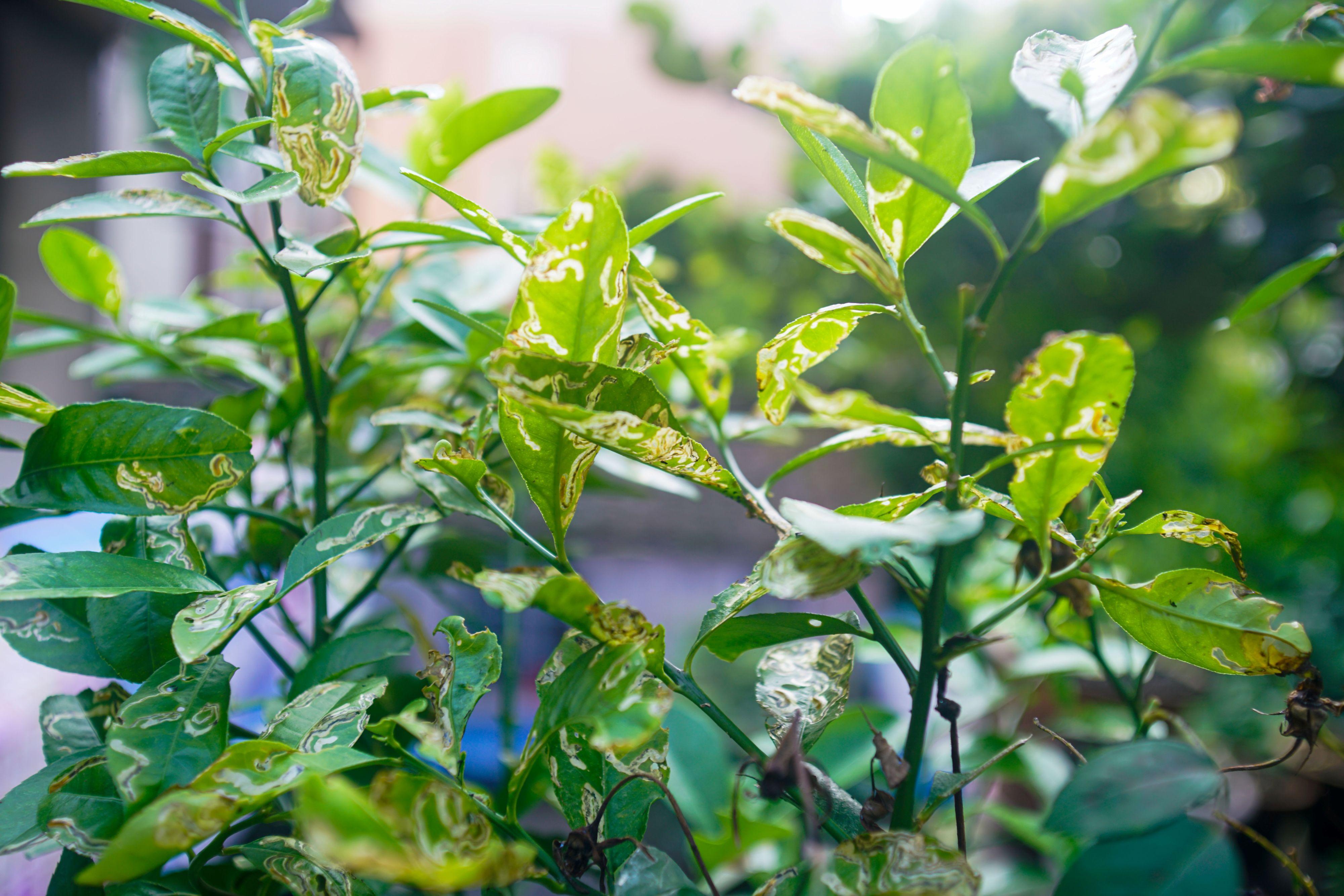Citrus leaf miners are voracious garden pests that chew through healthy young foliage and leave behind squiggly black tunnels. These insects then use the leaf tissue to make cozy sleeping quarters as they transform into their next life stage, causing the tree to be riddled with misshapen, rolled leaves. The damage looks dramatic, but healthy citrus trees usually recover and produce fruit in future seasons. Limit leaf miner destruction with these 7 easy tips for protecting your lemon tree.
1. Prune at the Right Time
Tender new foliage attracts citrus leaf miner moths, and pruning spurs plants to produce that new growth. Heavy pruning—removing one-third or more of a plant’s foliage—prompts copious amounts of new leaves to unfurl, which leaf miner moths prefer. Avoid pruning your lemon tree in summer and fall when leaf miner moth numbers are at their annual peak.
Instead, prune in early spring. March is ideal in many climates. Your lemon tree will quickly produce new growth, and the new foliage will mature long before leaf miner moths are searching for tender young leaves on which to lay their eggs.
Don’t prune off leaves damaged by citrus leaf miners. The undamaged areas of the leaves are still producing valuable energy for the tree.
2. Don’t Overfertilize
Too much fertilizer encourages a lemon tree to overproduce tender, succulent new growth. Opportunistic citrus leaf miner moths are attracted to this tender new growth because it is supple enough for the quarter-inch moths to sink their eggs into. The eggs hatch, and the destructive larvae begin tunneling through the foliage.
Citrus trees grow best with regular applications of all-purpose fertilizer in spring or summer. The frequency and amount of fertilizer depend on the age of the tree. Generally, mature trees—at least five years old—need about 1 pound of nitrogen annually. Semi-dwarf and smaller citrus trees need less fertilizer. Base the fertilizer applications on the size of your lemon tree and the fertilizer product, following package directions carefully.
3. Rinse Your Tree with a Strong Stream of Water
Mimic the cleansing power of rain by rinsing your lemon tree with water every few weeks. Use a hose nozzle to apply a strong, steady stream that washes off pests, honeydew, and sooty mold that can compromise the plant and make it more susceptible to leaf miner damage.
Related
4. Encourage Parasitic Wasps
Many native wasps parasitize citrus leaf miner larvae by laying their eggs on or near the larvae. When the parasitic wasp eggs hatch, the parasitic larvae consume the leaf miner larvae. Because there are so many native parasitic wasps, purchasing and releasing parasitic wasps is unnecessary to control a leaf miner population.
Instead, support the parasitic wasp population by planting flowering plants that provide pollen and nectar for these natural enemies. Attract native wasps with native plants. Research native plants in your region and plant them in groups of three or more to attract parasitic wasps. Note: parasitic wasps do not sting or bite people.
5. Don’t Spray Pesticides
Pesticides are not effective for controlling citrus leaf miners. The chemical cannot reach larvae buried inside leaf tissue. Instead of killing the leaf miner, the chemical potentially kills beneficial insects. Several natural or organic chemical controls are touted to be effective, but these products also potentially harm beneficial insects. The bottom line is that pesticides are ineffective against leaf miners so don’t spray your tree.
6. Remove Suckers and Water Sprouts
Suckers growing from the base or trunk of a citrus tree are vigorous shoots that grow rapidly and produce lots of new leaves that attract citrus leaf miners. Water sprouts are strongly upright stems rising from woody branches. Suckers and water sprouts are not beneficial to the tree and do not produce valuable fruit. Clip off these types of growths as soon as you notice them.
7. Choose to Tolerate Leafminers
While unsightly, leaf miners don’t harm lemon trees in the long term. Researchers have found that leaf miner populations peak and then decline in two to three years. After a few years of decreasing infection, the pests rarely trouble citrus trees. Rather than trying to eliminate leaf miners, focus on keeping your lemon tree healthy by fertilizing it as needed, watering it deeply during prolonged drought, and properly pruning broken and wayward branches.
Frequently Asked Questions
-
Yes, leaf miners attack potted citrus trees, especially those growing outside. Houseplant-type lemon trees are much less likely to be attacked by leaf miners.
-
The control and prevention methods for indoor citrus trees are the same as those for outdoor plants. Fertilize and prune indoor plants like you do outdoor trees, and do not spray pesticides. The damage is only aesthetic; your tree will likely recover in time.
-
It is likely sooty mold, which grows on the secretions of sap-sucking insects. Your plant is likely infested by a pest. Rinse the plant with a strong spray of water. Attempt to identify and eradicate the pest. Citrus leaf miners don’t have secretions on which sooty mold forms.



